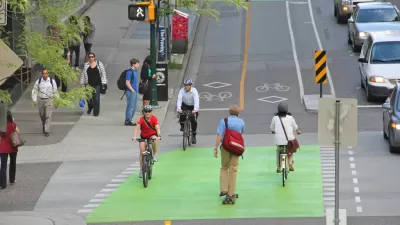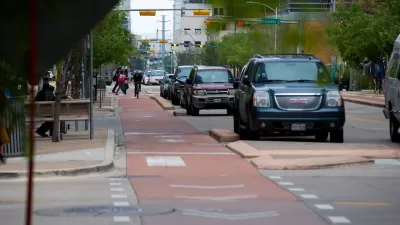Building protected bike lanes in Canada isn't as controversial as it once was. Maybe there's hope for the United States?

The Globe and Mail's editorial board dares to ask if the "war against bike lanes" is finally coming to end in Canada—with people on bikes emerging as the unlikely victor in this battle for public space.
The latest bike lane projects in Vancouver, under construction on Richard and Smithe streets on the city's downtown peninsula, moved forward without attracting controversy, , according to the editorial board—the opposite of bike lane projects in the late 2000s.
Take, for example, the opening of the city's first protected bike lane on the Burrard Bridge:
‘Chaos’ feared, blared one headline. “Doomed to failure,” opined a columnist. All that proved incorrect: The Burrard Bridge bike lane, billed as the busiest in North America, saw 1.4 million rides in 2020, 40 per cent more than its first full year a decade earlier.
The relative peace of the two latest projects in Vancouver tell a story that repeats all over the county, according to the editorial board:
Penticton, in the British Columbia Interior, this summer opened its Lake-to-Lake bike lane; it plans to invest $15-million over the next five years. Sarnia, Ont., is extending its bicycling network. In Halifax, about a third of a planned 57 kilometres of protected bike lanes is complete. It includes Hollis Street through the heart of the city. Montreal last November opened a long north-south route on Saint Denis Street as part of its Réseau express vélo network.
Toronto, spurred by the pandemic, has installed protected lanes across the city. One new segment on Bloor Street East opened in late September. These lanes are billed as temporary, but it would be a short-sighted mistake to reverse course.
What was once a "political flashpoint" and an "ideological signifier" is now "standard-issue" civic infrastructure.
FULL STORY: Is the war against bike lanes finally over?

Alabama: Trump Terminates Settlements for Black Communities Harmed By Raw Sewage
Trump deemed the landmark civil rights agreement “illegal DEI and environmental justice policy.”

Planetizen Federal Action Tracker
A weekly monitor of how Trump’s orders and actions are impacting planners and planning in America.

The 120 Year Old Tiny Home Villages That Sheltered San Francisco’s Earthquake Refugees
More than a century ago, San Francisco mobilized to house thousands of residents displaced by the 1906 earthquake. Could their strategy offer a model for the present?

Housing Vouchers as a Key Piece of Houston’s Housing Strategy
The Houston Housing Authority supports 19,000 households through the housing voucher program.

Rural Population Grew Again in 2024
Americans continued to move to smaller towns and cities, resulting in a fourth straight year of growth in rural areas.

Safe Streets Grants: What to Know
This year’s round of Safe Streets for All grant criteria come with some changes.
Urban Design for Planners 1: Software Tools
This six-course series explores essential urban design concepts using open source software and equips planners with the tools they need to participate fully in the urban design process.
Planning for Universal Design
Learn the tools for implementing Universal Design in planning regulations.
Clanton & Associates, Inc.
Jessamine County Fiscal Court
Institute for Housing and Urban Development Studies (IHS)
City of Grandview
Harvard GSD Executive Education
Toledo-Lucas County Plan Commissions
Salt Lake City
NYU Wagner Graduate School of Public Service





























